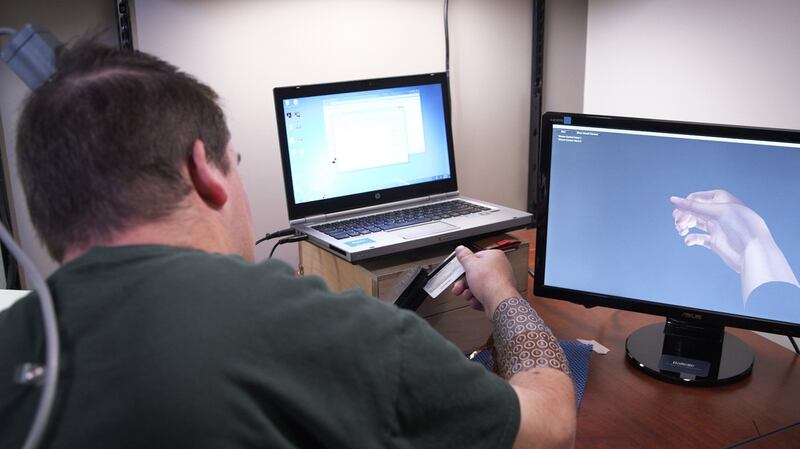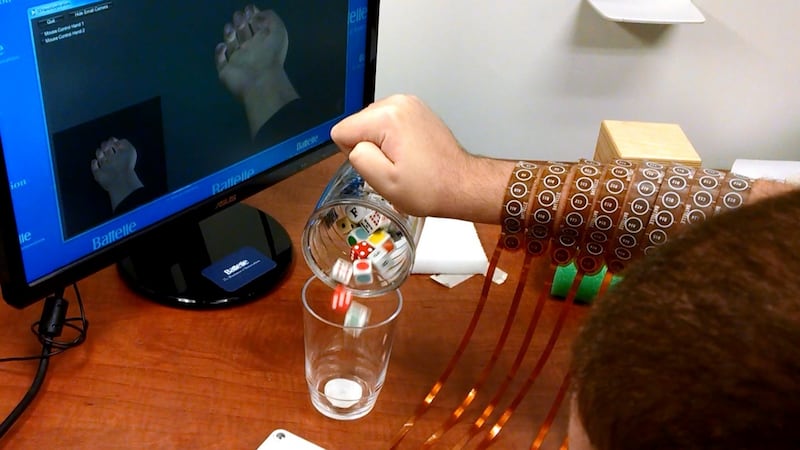A man with paralysed limbs can now pick up a spoon or hold a phone to his ear with movements controlled by his thoughts. A broken neck left him quadriplegic, but despite this he can grasp a bottle, pour its contents into a jar and then stir it with a stick.
The ground-breaking research represents the first time that forearm muscles in a human have been controlled directly by thought and opens the way to more advanced devices for restoring movement to paralysed limbs.
“The findings of this paper are so important for advancing the field of bioelectronic medicine, a new field that is exploding, that it really will help advance the technology that will provide new options for these patients,” says American researcher Chad Bouton.


He, along with Nick Annetta and Ali Rezai and other colleagues, published this remarkable research on April 13th in the journal Nature.
"This is the first time a completely paralysed person has regained movement just by using their thoughts," says Dr Bouton, of the Feinstein Institute for Medical Research in the US.
"Now I can think about what I want to do and now I can do it," says Ian Burkhart, a 24-year-old quadriplegic from Dublin, Ohio, on whom the Nature paper is based. "It was a big shock. [The movement] was so fluid-like before the accident."
Major spinal-cord injuries cause loss of limb movement because muscle-controlling signals relayed back and forth from the brain are blocked.
“With this injury, signals from his brain in the motor-cortex area – the area responsible for movement – are intact but the signals arrive at the injury in the spinal cord and are blocked and can’t get to his muscles,” Dr Bouton says.
The researchers overcame this by creating an electronic "neural bypass" that includes a pea-sized microchip implant in the person's brain. The implant is able to read neural activity in the motor cortex..
Brain patterns
The researchers, who included scientists from the Ohio State University Wexner Medical Centre and the Battelle Memorial Institute, studied Burkhart's brain activity, looking for the patterns related to movements such as grasping, twisting the wrists and pinching a thin object between fingers to pick it up.
They developed mathematical algorithms and used these with computer learning to recognise the brain activity patterns for distinct movements.
With these brain patterns mapped, the researchers needed a way to make the muscles move. They developed a “muscle stimulation sleeve”, which wraps around the forearm and delivers a tiny electric shock to make a muscle flex in unison with others.
The researchers had to learn the proper sequence of muscle stimulation to achieve smooth movement of the hand and arm. The sleeve works in response to Burkhart thinking about moving his hand or fingers
Without the NeuroLife device, Burkhart is unable to control hand or arm movements, but after training three days each week over 15 months, he is now able to make six different wrist and hand movements and isolated finger movements, including pinching, the researchers say.
Even though the spinal-cord connection is broken, the researchers' neural bypass provides a way for the brain to reconnect with muscle groups to achieve controlled motion.
"These results have significant implications in advancing neuroprosthetic technology for people worldwide living with the effects of paralysis," the authors write.
"We are hoping that this technology will evolve into a wireless system connecting brain signals and thoughts to the outside world to improve the function and quality of life for those with disabilities," says Dr Ali Rezai, a neurosurgeon at the Wexner Medical Centre, who connected the implant.
Regain movement
The implant is on the left side of the brain and so the right hand benefits from what it can do, but there is no reason why other limbs might not also regain movement.
The device could also be used to help restore movement in other types of spinal-cord injuries, in patients who have had strokes or traumatic brain injury, the researchers believe.
The researchers want to extend the study to include up to five participants, and have identified one who will join the study this summer. “In the 30 years I have been in this field, this is the first time we’ve been able to offer realistic hope to people who have very challenging lives,” says Dr Jerry Mysiw, chairman of the department of physical medicine and rehabilitation at the Wexner Medical Centre.
IAN BURKHART: 'I HAVE A LOT MORE HOPE FOR THE FUTURE'
Four years ago Ian Burkhart broke his neck in a diving accident while on holiday.
The break was well up the spinal cord, far enough to sever the brain’s connection with his limbs, rendering him quadriplegic.
Now he can reach out, pick up a bottle and pour its contents into a jar. His hand movements are surprisingly fluid and completely controlled by the power of his own thoughts.
He can also pinch his fingers together to pick up a thin stick he uses to stir the contents of the jar. Although it doesn’t hold coffee in the demonstration, one can easily imagine him reaching for a spoon to stir in milk.
The same holds true with the other movements he has mastered with the NeuroLife device.
Motion such as pivoting the wrist or reaching out to grip an object are basic to daily activity.
He can once again swipe a credit card and play a video game guitar with his own finger and hand movements.
Burkhart speaks about the loss of independence in the months after his accident, saying that even the most basic things are beyond his ability.
He has started to win back his lost independence. “If you can give back that ability, it is huge,” he says.
He had no hesitation joining the research trial for the device. “I just kind of think that it’s my obligation to society,” he says. “If someone else had an opportunity to do it in some other part of the world, I would hope that they would commit their time so that everyone can benefit from it in the future,” he says. “Participating in this research has changed me in the sense that I have a lot more hope for the future now.”










